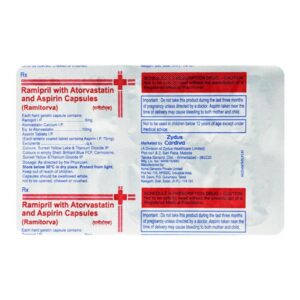RAMIPRIL + ATORAVASTATIN
Ramipril: Ramipril is a prescription drug that belongs to the class of medications called angiotensin-converting enzyme (ACE) inhibitors. It is primarily used to treat high blood pressure (hypertension) and congestive heart failure. Additionally, it may be prescribed to lower the risk of heart attack, stroke, and other heart-related conditions in patients who have a high risk.
The mechanism of action of ramipril involves inhibiting the activity of the ACE enzyme. ACE normally converts angiotensin I to angiotensin II, which causes blood vessels to constrict and promotes the release of aldosterone, a hormone that leads to sodium and fluid retention. By inhibiting ACE, ramipril helps relax and widen the blood vessels, reducing blood pressure and improving blood flow. It also reduces the production of aldosterone, leading to decreased sodium and fluid retention.
The initial recommended dose of ramipril for hypertension is 2.5 mg once daily, which can be gradually increased under the supervision of a healthcare provider to a maximum dose of 20 mg per day. The recommended starting dose for heart failure is typically 1.25 mg once daily, and it can be increased to a target dose of 10 mg per day.
As with any medication, ramipril can cause side effects in some individuals. Common side effects may include dizziness, headache, cough, fatigue, nausea, vomiting, diarrhea, and skin rash. Some people may experience more serious side effects such as swelling of the face, lips, tongue, or throat, difficulty breathing, chest pain, irregular heartbeat, and signs of an allergic reaction. It is important to seek immediate medical attention if any severe side effects occur.
It is essential to take ramipril as prescribed by a healthcare professional and not to stop taking it abruptly without consulting a doctor. This drug may interact with other medications, so it’s important to inform your healthcare provider about all the medications, supplements, and herbal products you are currently taking.
Atoravastatin: Atorvastatin is a medication used to lower high cholesterol levels and prevent cardiovascular diseases. It belongs to a class of drugs called statins, which work by inhibiting the enzyme HMG-CoA reductase, responsible for cholesterol synthesis in the liver.
The primary use of Atorvastatin is to reduce LDL (low-density lipoprotein) cholesterol, commonly known as “bad” cholesterol, as well as triglycerides in the blood. It also increases HDL (high-density lipoprotein) cholesterol, the “good” cholesterol. By lowering LDL cholesterol levels, Atorvastatin helps prevent the build-up of plaque in the arteries, reducing the risk of heart attack, stroke, and other cardiovascular complications.
The dosage of Atorvastatin varies depending on individual circumstances and should be determined by a healthcare professional. The typical initial dose for most adults is 10 to 20 mg once daily, which may be adjusted as needed. The maximum recommended dose is 80 mg daily. It is usually taken with a full glass of water and can be taken with or without food.
As with any medication, Atorvastatin can cause side effects in some individuals. Common side effects include headache, muscle pain or weakness, diarrhea, and nausea. In rare cases, more serious side effects may occur, such as liver problems, rhabdomyolysis (breakdown of muscle tissue), or an allergic reaction. Immediate medical attention should be sought if any severe side effects occur.
It is important to note that Atorvastatin may interact with other medications, including certain antibiotics, antifungal drugs, and heart medications. Therefore, it is crucial to inform your healthcare provider about all the medications you are taking to avoid potential interactions.
Atorvastatin is a widely prescribed and effective medication for managing cholesterol levels and reducing the risk of cardiovascular diseases. However, it is essential to use it under the supervision of a healthcare professional and to follow their instructions regarding dosage, side effects, and interaction with other medications.

